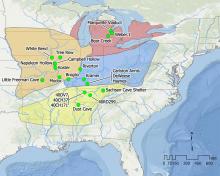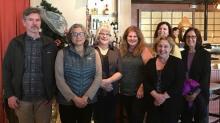Sharing Scientific Research
This website shares scientific, archaeological research conducted with support from a National Science Foundation (NSF) Grant (Anthropology Program, BCS-1430754) to Co-Principal Investigators Dr. Sarah Neusius, Indiana University of Pennsylvania, and Dr. Bonnie Styles, Illinois State Museum. From 2014-2017, Drs. Neusius and Styles co-directed the research project and addressed two major goals.
The first goal is to preserve and make accessible zooarchaeological databases from important Archaic Period (10,500-2,500 RCYBP) archaeological sites in the interior North American Eastern Woodlands (see map below).
The second goal is to analyze these datasets to test hypotheses about the roles of environmental and cultural variability and changes on human use of animals during this time period, particularly the use of aquatic resources.
We thank Frank McManamon, Executive Director of Digital Antiquity, and Adam Brin, Director of Technology for Digital Antiquity, who were instrumental in the development of the Digital Archaeological Record. We also thank Kate Spielmann and Keith Kintigh, who led the integration of zooarchaeological data in tDAR and served as advisors for our project.
We established the Eastern Archaic Faunal Working Group (see list below) to undertake this collaborative project. This group uploaded and preserved about 60 faunal datasets for 24 Archaic Period sites in the Digital Archaeological Record (tDAR). An international repository of digital data, images, and documents, tDAR (www.tDAR.org) is maintained by Digital Antiquity and hosted by Arizona State University. We chose to upload our data into tDAR because of the digital archiving capability and long-term commitment of Digital Antiquity to preserve and provide open access to the data. We used the mapping and integration tools in tDAR to compare datasets developed by different researchers using different formats. Our databases are now released in tDAR and are accessible to researchers across the world.
This map shows the study area, subregions, and Archaic Period archaeological sites included in our NSF-funded grant project.
Eastern Archaic Faunal Working Group Sites
In 2015, Co-Principal Investigator Sarah Neusius took this image of our team at one of our initial NSF-sponsored workshops at the Illinois State Museum (lower image). Pictured from left to right are Steve Kuehn, George Crothers, Adam Brin (Director of Technology, Digital Antiquity, Arizona State University), Tanya Peres, Bonnie Styles, Renee Walker, Alan Huber (Indiana University of Pennsylvania), Beverley Smith, and Mona Colburn.
Eastern Archaic Faunal Working Group Collaborators
Dr. Sarah W. Neusius, P.I., Indiana University of Pennsylvania
Dr. Bonnie W. Styles, P.I., Illinois State Museum
Mona Colburn, Project Zooarchaeology Specialist, Illinois State Museum
Dr. George Crothers, University of Kentucky
Dr. Steve Kuehn, Illinois State Archaeological Survey
Dr. Tanya Peres, Florida State University
Scott Rivas, Graduate Assistant, Indiana University of Pennsylvania
Dr. Beverley Smith, University of Michigan-Flint
Dr. Renee Walker, State University of New York-Oneonta
The face-to-face meetings were critical to our project. They provided the training needed for the whole team to become familiar with tDAR and to learn how to best prepare our individual datasets for ingestion into tDAR. They contributed to consistency in how each of us mapped attributes for variables in our individual datasets to the attributes in the shared ontologies. They provided the time needed to discuss problems and make observations. Finally, they were essential to addressing our research hypotheses and the development of publication and future research plans.
We thank the National Science Foundation for supporting our research project and the development of this website.
Website Development and Credits
This website introduces the general public to the science of zooarchaeology and what we have learned from the bones and shells from archaeological sites. The examples provided stem from the research undertaken for the NSF grant with a focus on interpretations from the Koster site and Modoc Rock Shelter in Illinois. The website is designed for the general public and to be accessible to students from seventh grade through undergraduate college.
Website Project Director: Dr. Bonnie Styles, Director Emeritus, Illinois State Museum and Adjunct Professor in Anthropology, Northwestern University
Website Authors: Bonnie W. Styles and Sue Huitt
Website Concept and Content Development: Dr. Bonnie Styles
Image Preparation, Technical and Pedagogical Editing, Website Layout and Implementation: Sue Huitt, Website Consultant, NSF Grant
Overall Website Design and Assistance: Dr. Erich Schroeder and Kelvin Sampson, Illinois State Museum
Website Funding: National Science Foundation, Anthropology Program (BCS-1430754): “Adaptation and Cultural Practices During the Archaic Period in the Interior North American Eastern Woodlands: Creating and Integrating Digital Faunal Databases in tDAR,” Co-Principal Investigators, Dr. Sarah Neusius, Indiana University of Pennsylvania, and Dr. Bonnie Styles, Illinois State Museum.
Copyright and Use Policies of the Illinois State Museum: https://www.illinoisstatemuseum.org/content/copyright-and-use-policies






